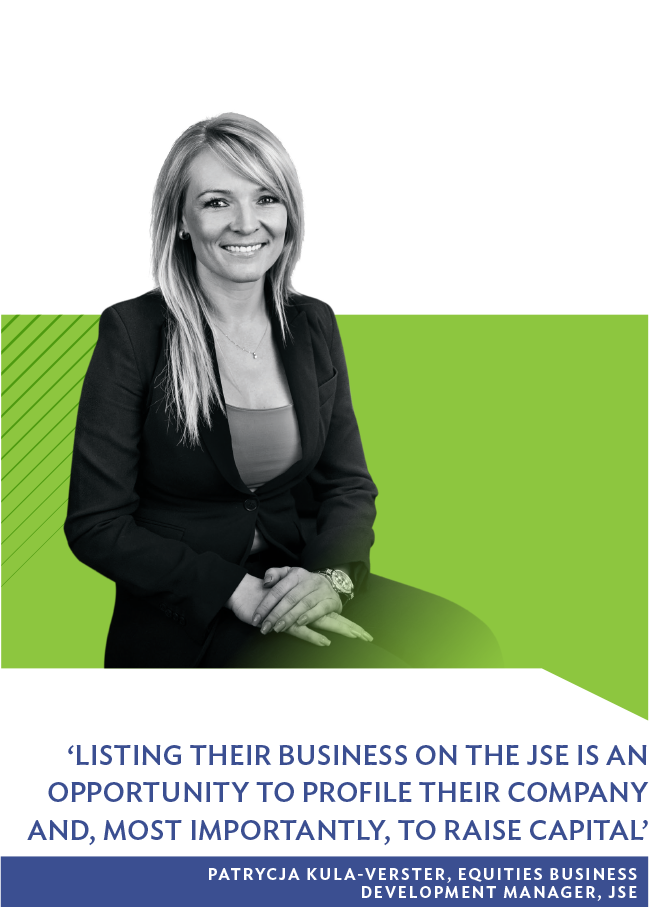Capital for investing in privately owned companies has historically been conducted via private equity (PE) funding. Usually these PE firms exit their investments after a certain time frame (usually less than 10 years) after returning a profit. Typically they would have to return to their existing pool of investors to raise any new capital required, for example, for further expansion projects during this period.
However, the current economic climate has seen several interesting developments emerging regarding initiatives to raise investment capital. One of these is the permanent capital vehicle (PCV), explains Patrycja Kula-Verster, Primary Market Equities Business Development Manager for the JSE.
‘This is an entity for raising and managing capital over a medium- to long-term time frame,’ she says. ‘Listed PCVs also have another great advantage – they allow the public to invest in entities that would have only been available to institutional investors or PE firms’ investors.’
PCVs may be ideally structured for PE listings. ‘From a JSE perspective, we are continuously engaging with potential issuers around the prospects of listing – in fact our engagements extend to the broader ecosystem, which includes private equity. In the context of private equity, these firms will have an investment horizon of, say, five to seven years. They invest in a company and once they reach the investment horizon they need to exit that investment. We encourage them to list these companies.’
Kula-Verster says companies that come from a private equity investment house are well suited to a public listing as they are generally familiar with all the disclosure requirements.
‘For companies that are listed on the JSE, there is a relatively smooth transition from the unlisted into the listed environment, as these private businesses are used to reporting to their private equity investors and are corporatised. Listing gives them the opportunity to attract a new spread of shareholders, and these investors now have the opportunity to take part in the company’s next growth phase.
‘The JSE has deep pools of capital in SA. There is significant capital available from institutional investors – the assets of our non-banks are around R9 trillion, about twice the size or just under twice the size of the assets of the banks – and these funds are continuously looking for new investment opportunities,’ says Kula-Verster.
According to the World Economic Forum’s Global Competiveness Index 2016/17, the JSE is ranked first out of 138 countries for financing through the local equity market. This means that once companies are listed on the JSE, they are also able to go back to current and new shareholders to raise additional capital. Last year the JSE raised R116 billion through secondary capital raising. This shows that listed companies are using their JSE listing to tap the market for further capital raisings.
The JSE also has a high foreign investor participation rate, which equates to approximately 30% to 40% of the foreign daily value trade.
Last year, Mauritian-based Ethos Private Equity, Africa’s largest private equity firm, listed an investment holding company on the JSE. Through Ethos Capital Partners, it raised R1.8 billion and gave retail investors access to three of its funds. The company invests directly and indirectly in a wide spectrum of sectors, from manufacturing and retail property to the cellular industry.
‘Despite living in an economy where there is uncer-tainty, there are fantastic businesses out there that need to raise capital. Listing their business on the JSE is an opportunity to profile their company and, most importantly, to raise capital and take their company to the next level – whether it’s expanding within South Africa or outside of the borders.’
Independent education group, Curro, which started out with 28 pupils in a church in 1998, is a prime example of how listing can cascade into greater opportunities. It listed on the AltX board in June 2011 and raised R322.4 million on listing. Within a year it had migrated to the Main Board of the JSE. The company’s goal was to open 40 schools by 2020 but, through listings, it was able to achieve its objective five years early. Apart from raising equity capital, it has raised a total of R2 billion in secondary capital on the JSE. It has started expanding its tertiary education business, Stadio Holdings, which will soon be unbundled out of Curro and listed separately on the JSE.









